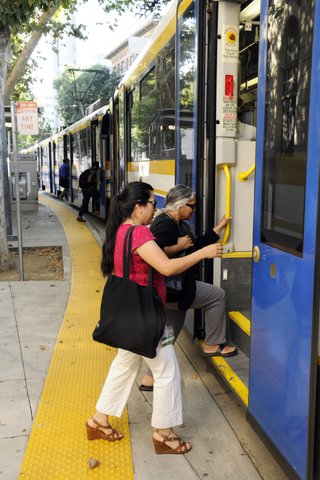In the next few days, the Sacramento Regional Transit District expects to sign a contract with Lamar Advertising to transform its light rail vehicles into moving billboards.
Unfortunately, the billboards will act as a glossy concealer masking aging vehicles near the end of a 30-year life cycle. Nearly one-third of the agency’s light rail fleet is in serious need of rehab or replacement, said CEO and general manager Henry Li, but the agency can’t afford the needed $140 million in repairs.
Measure B, the Sacramento County transportation funding measure that fell short of passage this month, would have brought RT an additional $28 million beginning next fiscal year. The contract with Lamar only guarantees $500,000 in annual revenue.
RT can’t afford to replace a single train. As a consequence, its vehicles are more likely to break down, an event that maroons passengers for about 30 minutes until an alternative vehicle arrives, Li said. And the cost that goes into maintenance leaves fewer dollars to maintain current service. So without a significant revenue increase, the agency will need to consider a round of service cuts at some point, Li said.
“We do not want that to happen,” said Li. “That’s why we need another (ballot) measure in two years.”
Li said he has begun conversations with businesses and elected officials on options for a 2018 ballot measure. That discussion is just getting underway, he said.
Since it is a public agency, RT was unable to actively campaign for Measure B, although Li did highlight the fact that RT receives less sales tax funding than other cities. He had also promised to use Measure B funding to improve cleanliness, reliability and safety.
The agency is now considering a host of cost-cutting maneuvers, with the board expected to vote on a plan in February. Employee layoffs are not on the table, said Li, but the agency is looking to reorganize operations in a way that would eliminate positions that are currently vacant.
Over the last three years, RT blew through $6.6 million of its reserves, and had to raise fares over the summer to avoid exhausting its rainy day fund. Reserves now stand at about $4 million, Li said. A healthy reserve fund would be closer to $15 million, he said.
In brighter news, the 25 agents hired by the agency over the summer to check tickets and catch freeloading passengers is having a positive effect. The number of freeloading passengers is now estimated to be fewer than 5 percent of overall riders. That’s down from 15 percent, Li said. Paying riders have reported feeling safer.
Golden 1 Center has brought in about 1,500 new riders for each sold-out event, Li said. While the CEO is encouraged to see a new population riding the train, the ridership bump is not statistically significant (RT averages 1 million riders per month).
As for other options to scrounge revenue, RT has 17 surplus properties near light-rail stations that could be sold for several million dollars, Li said. The executive also hopes the California Legislature approves a delayed statewide transportation funding plan in 2017.
Though the bill is almost certain to undergo major changes, the current state funding proposal by the two chairs of the Senate and Assembly transportation committees would direct just over $10 million annually to RT.
